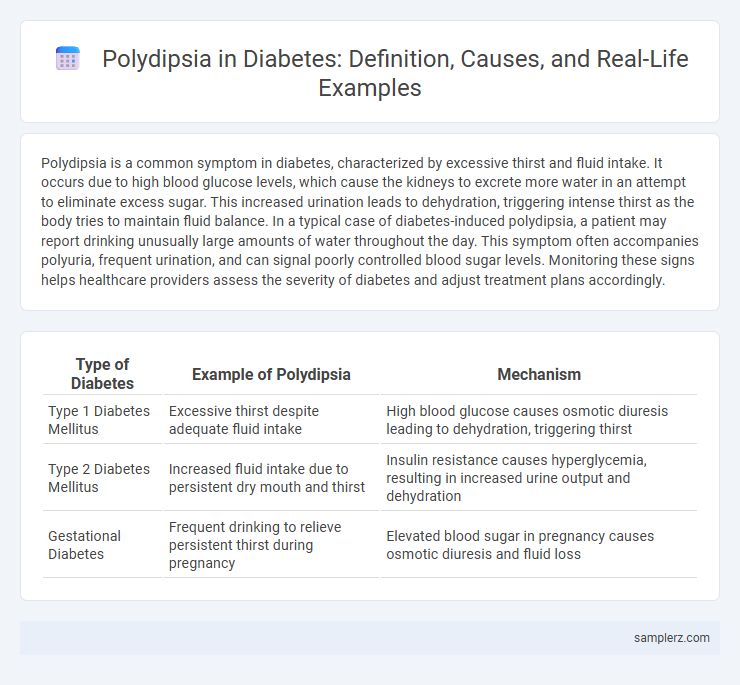Polydipsia is a common symptom in diabetes, characterized by excessive thirst and fluid intake. It occurs due to high blood glucose levels, which cause the kidneys to excrete more water in an attempt to eliminate excess sugar. This increased urination leads to dehydration, triggering intense thirst as the body tries to maintain fluid balance. In a typical case of diabetes-induced polydipsia, a patient may report drinking unusually large amounts of water throughout the day. This symptom often accompanies polyuria, frequent urination, and can signal poorly controlled blood sugar levels. Monitoring these signs helps healthcare providers assess the severity of diabetes and adjust treatment plans accordingly.
Table of Comparison
| Type of Diabetes | Example of Polydipsia | Mechanism |
|---|---|---|
| Type 1 Diabetes Mellitus | Excessive thirst despite adequate fluid intake | High blood glucose causes osmotic diuresis leading to dehydration, triggering thirst |
| Type 2 Diabetes Mellitus | Increased fluid intake due to persistent dry mouth and thirst | Insulin resistance causes hyperglycemia, resulting in increased urine output and dehydration |
| Gestational Diabetes | Frequent drinking to relieve persistent thirst during pregnancy | Elevated blood sugar in pregnancy causes osmotic diuresis and fluid loss |
Understanding Polydipsia in Diabetes
Polydipsia in diabetes manifests as an excessive thirst due to high blood glucose levels causing osmotic diuresis and dehydration. This symptom signals uncontrolled hyperglycemia, often observed in both type 1 and type 2 diabetes mellitus. Recognizing polydipsia is critical for early diagnosis and effective management to prevent diabetic ketoacidosis and other complications.
Causes of Excessive Thirst in Diabetic Patients
Polydipsia in diabetes primarily results from high blood glucose levels causing osmotic diuresis, which leads to excessive water loss and triggers intense thirst. Insufficient insulin or insulin resistance hinders glucose uptake by cells, causing hyperglycemia and subsequent dehydration that stimulates the hypothalamic thirst center. Chronic kidney impairment in advanced diabetes can also contribute to fluid imbalance, exacerbating persistent excessive thirst in affected patients.
Classic Signs of Polydipsia in Diabetes
Classic signs of polydipsia in diabetes include excessive thirst and frequent urination caused by high blood glucose levels leading to dehydration. Patients often report persistent dry mouth and an unquenchable thirst despite fluid intake. These symptoms arise as the kidneys attempt to remove excess glucose, resulting in significant fluid loss and triggering intense thirst signals.
How Uncontrolled Blood Sugar Leads to Polydipsia
Uncontrolled blood sugar levels in diabetes cause excessive glucose to accumulate in the bloodstream, leading to osmotic diuresis where the kidneys excrete more water to dilute the glucose. This increased urine output results in dehydration, triggering the hypothalamus to stimulate intense thirst, known as polydipsia. Persistent hyperglycemia without proper insulin regulation exacerbates fluid loss and elevates the severity of polydipsia in diabetic patients.
Real-Life Example: A Day with Diabetic Polydipsia
A person with diabetes experiencing polydipsia may drink excessive amounts of water throughout the day, often consuming more than 3 to 4 liters to combat intense thirst caused by high blood glucose levels. This condition results from the kidneys working to excrete excess glucose, leading to dehydration and triggering persistent thirst signals. Managing polydipsia includes regular blood sugar monitoring and adhering to prescribed insulin or medication regimens to maintain glucose levels within a normal range.
Differentiating Polydipsia from Normal Thirst in Diabetes
Polydipsia in diabetes is characterized by excessive thirst that persists despite adequate fluid intake, distinguishing it from normal thirst caused by mild dehydration or environmental factors. Elevated blood glucose levels lead to osmotic diuresis, triggering intense, unrelenting thirst unique to diabetes mellitus patients. Monitoring serum glucose and urine osmolality helps differentiate pathological polydipsia from transient, physiological thirst responses.
The Link Between Polyuria and Polydipsia
Polydipsia in diabetes is closely linked to polyuria, where excessive glucose levels in the blood lead to increased urination as the kidneys attempt to remove excess sugar. This abnormal loss of fluids triggers intense thirst, causing individuals to experience polydipsia. Managing blood glucose levels effectively helps reduce both polyuria and polydipsia, mitigating dehydration risks in diabetic patients.
Polydipsia as an Early Warning Sign of Diabetes
Polydipsia, characterized by excessive thirst, is a common early warning sign of diabetes mellitus, especially in type 1 and type 2 diabetes. This symptom occurs due to high blood glucose levels causing osmotic diuresis, leading to dehydration and increased fluid intake. Monitoring persistent polydipsia can facilitate early diagnosis and management of diabetes, preventing severe complications like diabetic ketoacidosis.
Managing Polydipsia in Diabetic Individuals
Managing polydipsia in diabetic individuals involves strict blood glucose control through insulin therapy and regular monitoring to prevent excessive thirst caused by hyperglycemia. Hydration strategies include encouraging frequent water intake to avoid dehydration while balancing electrolyte levels to prevent complications. Lifestyle modifications alongside medication adherence play a crucial role in reducing the severity of polydipsia and improving overall diabetic management.
When to Seek Medical Help for Polydipsia in Diabetes
Persistent excessive thirst, known as polydipsia, is a common symptom in diabetes that signals high blood sugar levels needing urgent attention. If polydipsia is accompanied by symptoms such as frequent urination, unexplained weight loss, extreme fatigue, or blurred vision, immediate medical evaluation is critical to prevent complications like diabetic ketoacidosis. Early intervention by healthcare professionals can help manage blood glucose levels effectively and reduce the risk of severe diabetes-related emergencies.

example of polydipsia in diabetes Infographic
 samplerz.com
samplerz.com